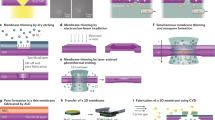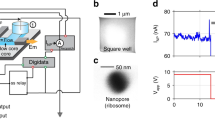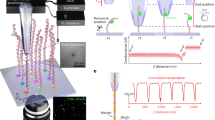Abstract
Nanopore sensors have attracted considerable interest for high-throughput sensing of individual nucleic acids and proteins without the need for chemical labels or complex optics. A prevailing problem in nanopore applications is that the transport kinetics of single biomolecules are often faster than the measurement time resolution. Methods to slow down biomolecular transport can be troublesome and are at odds with the natural goal of high-throughput sensing. Here we introduce a low-noise measurement platform that integrates a complementary metal-oxide semiconductor (CMOS) preamplifier with solid-state nanopores in thin silicon nitride membranes. With this platform we achieved a signal-to-noise ratio exceeding five at a bandwidth of 1 MHz, which to our knowledge is the highest bandwidth nanopore recording to date. We demonstrate transient signals as brief as 1 μs from short DNA molecules as well as current signatures during molecular passage events that shed light on submolecular DNA configurations in small nanopores.
This is a preview of subscription content, access via your institution
Access options
Subscribe to this journal
Receive 12 print issues and online access
$259.00 per year
only $21.58 per issue
Buy this article
- Purchase on Springer Link
- Instant access to full article PDF
Prices may be subject to local taxes which are calculated during checkout






Similar content being viewed by others
References
Weiss, S. Fluorescence spectroscopy of single biomolecules. Science 283, 1676–1683 (1999).
Kasianowicz, J.J., Brandin, E., Branton, D. & Deamer, D.W. Characterization of individual polynucleotide molecules using a membrane channel. Proc. Natl. Acad. Sci. USA 93, 13770–13773 (1996).
Howorka, S. & Siwy, Z. Nanopore analytics: sensing of single molecules. Chem. Soc. Rev. 38, 2360–2384 (2009).
Branton, D. et al. The potential and challenges of nanopore sequencing. Nat. Biotechnol. 26, 1146–1153 (2008).
Venkatesan, B.M. & Bashir, R. Nanopore sensors for nucleic acid analysis. Nat. Nanotechnol. 6, 615–624 (2011).
Cherf, G.M. et al. Automated forward and reverse ratcheting of DNA in a nanopore at 5-Å precision. Nat. Biotechnol advance online publication, doi:10.1038/nbt.2147 (14 February 2012).
Wanunu, M. et al. Rapid electronic detection of probe-specific microRNAs using thin nanopore sensors. Nat. Nanotechnol. 5, 807–814 (2010).
Sakmann, B. & Neher, E. Single-Channel Recording (Springer, 2009).
Hille, B. Ion Channels of Excitable Membranes 3rd edn. (Sinauer, 2001).
Derrington, I.M. et al. Nanopore DNA sequencing with MspA. Proc. Natl. Acad. Sci. USA 107, 16060–16065 (2010).
Kowalczyk, S.W., Grosberg, A.Y., Rabin, Y. & Dekker, C. Modeling the conductance and DNA blockade of solid-state nanopores. Nanotechnology 22, 315101 (2011).
Smeets, R., Keyser, U., Dekker, N. & Dekker, C. Noise in solid-state nanopores. Proc. Natl. Acad. Sci. USA 105, 417–421 (2008).
Hoogerheide, D., Garaj, S. & Golovchenko, J. Probing surface charge fluctuations with solid-state nanopores. Phys. Rev. Lett. 102, 256804 (2009).
Tabard-Cossa, V., Trivedi, D., Wiggin, M., Jetha, N.N. & Marziali, A. Noise analysis and reduction in solid-state nanopores. Nanotechnology 18, 305505 (2007).
Dimitrov, V. et al. Nanopores in solid-state membranes engineered for single molecule detection. Nanotechnology 21, 065502 (2010).
Ferrari, G., Gozzini, F., Molari, A. & Sampietro, M. Transimpedance amplifier for high sensitivity current measurements on nanodevices. IEEE J. Solid-State Circuits 44, 1609–1616 (2009).
Heng, J.B. et al. Sizing DNA using a nanometer-diameter pore. Biophys. J. 87, 2905–2911 (2004).
Wanunu, M., Sutin, J., McNally, B., Chow, A. & Meller, A. DNA translocation governed by interactions with solid-state nanopores. Biophys. J. 95, 4716–4725 (2008).
Aksimentiev, A., Heng, J.B., Timp, G. & Schulten, K. Microscopic kinetics of DNA translocation through synthetic nanopores. Biophys. J. 87, 2086–2097 (2004).
Heng, J.B. et al. Stretching DNA using the electric field in a synthetic nanopore. Nano Lett. 5, 1883–1888 (2005).
Pedone, D., Firnkes, M. & Rant, U. Data analysis of translocation events in nanopore experiments. Anal. Chem. 81, 9689–9694 (2009).
Li, J., Gershow, M., Stein, D., Brandin, E. & Golovchenko, J.a. DNA molecules and configurations in a solid-state nanopore microscope. Nat. Mater. 2, 611–615 (2003).
Vercoutere, W. et al. Rapid discrimination among individual DNA hairpin molecules at single-nucleotide resolution using an ion channel. Nat. Biotechnol. 19, 248–252 (2001).
Akeson, M., Branton, D., Kasianowicz, J.J., Brandin, E. & Deamer, D.W. Microsecond time-scale discrimination among polycytidylic acid, polyadenylic acid, and polyuridylic acid as homopolymers or as segments within single RNA molecules. Biophys. J. 77, 3227–3233 (1999).
Shapovalov, G. & Lester, H.A. Gating transitions in bacterial ion channels measured at 3-microsecond resolution. J. Gen. Physiol. 124, 151–161 (2004).
Tsutsui, M., Taniguchi, M., Yokota, K. & Kawai, T. Identifying single nucleotides by tunnelling current. Nat. Nanotechnol. 5, 286–290 (2010).
Xie, P., Xiong, Q., Fang, Y., Qing, Q. & Lieber, C.M. Local electrical potential detection of DNA by nanowire–nanopore sensors. Nat. Nanotechnol. 7, 119–125 (2012).
Sorgenfrei, S. et al. Label-free single-molecule detection of DNA-hybridization kinetics with a carbon nanotube field-effect transistor. Nat. Nanotechnol. 6, 126–132 (2011).
Klepeis, J.L., Lindorff-Larsen, K., Dror, R.O. & Shaw, D.E. Long-timescale molecular dynamics simulations of protein structure and function. Curr. Opin. Struct. Biol. 19, 120–127 (2009).
Gershow, M. & Golovchenko, J.a. Recapturing and trapping single molecules with a solid-state nanopore. Nat. Nanotechnol. 2, 775–779 (2007).
Luan, B. et al. Base-by-base ratcheting of single stranded DNA through a solid-state nanopore. Phys. Rev. Lett. 104, 238103 (2010).
Polk, B.J., Stelzenmuller, A., Mijares, G., MacCrehan, W. & Gaitan, M. Ag/AgCl microelectrodes with improved stability for microfluidics. Sensors Actuators Biol. Chem. 114, 239–247 (2006).
Wanunu, M. & Meller, A. Chemically modified solid-state nanopores. Nano Lett. 7, 1580–1585 (2007).
Acknowledgements
We thank K. Venta, M. Puster, K. Healy, V. Ray, C. Dean and L. Paninski for their assistance. K.L.S. acknowledges partial support from the Semiconductor Research Corporation through the Focus Center Research Program, the US National Institutes of Health (R33HG003089) and the Office of Naval Research (N00014-09-1-1117). M.D. acknowledges support from the National Institutes of Health (R21HG004767, American Recovery and Reinvestment Act Supplement to R21HG004767 and R21HG006313).
Author information
Authors and Affiliations
Contributions
J.K.R., K.L.S. and M.D. developed the platform concept. J.K.R. designed the amplifier and measurement system. J.K.R., K.L.S., M.W. and M.D. planned experiments. M.W. and C.A.M. fabricated nanopores. J.K.R. and M.W. performed nanopore experiments and analyzed data. J.K.R. and K.L.S. wrote the manuscript. All authors edited the manuscript.
Corresponding authors
Ethics declarations
Competing interests
The authors declare no competing financial interests.
Supplementary information
Supplementary Text and Figures
Supplementary Discussion (PDF 1034 kb)
Rights and permissions
About this article
Cite this article
Rosenstein, J., Wanunu, M., Merchant, C. et al. Integrated nanopore sensing platform with sub-microsecond temporal resolution. Nat Methods 9, 487–492 (2012). https://doi.org/10.1038/nmeth.1932
Received:
Accepted:
Published:
Issue Date:
DOI: https://doi.org/10.1038/nmeth.1932
This article is cited by
-
Spatially multiplexed single-molecule translocations through a nanopore at controlled speeds
Nature Nanotechnology (2023)
-
Reconfigurable heterogeneous integration using stackable chips with embedded artificial intelligence
Nature Electronics (2022)
-
Field effect control of translocation dynamics in surround-gate nanopores
Communications Materials (2021)
-
Slowing down DNA translocation through solid-state nanopores by edge-field leakage
Nature Communications (2021)



